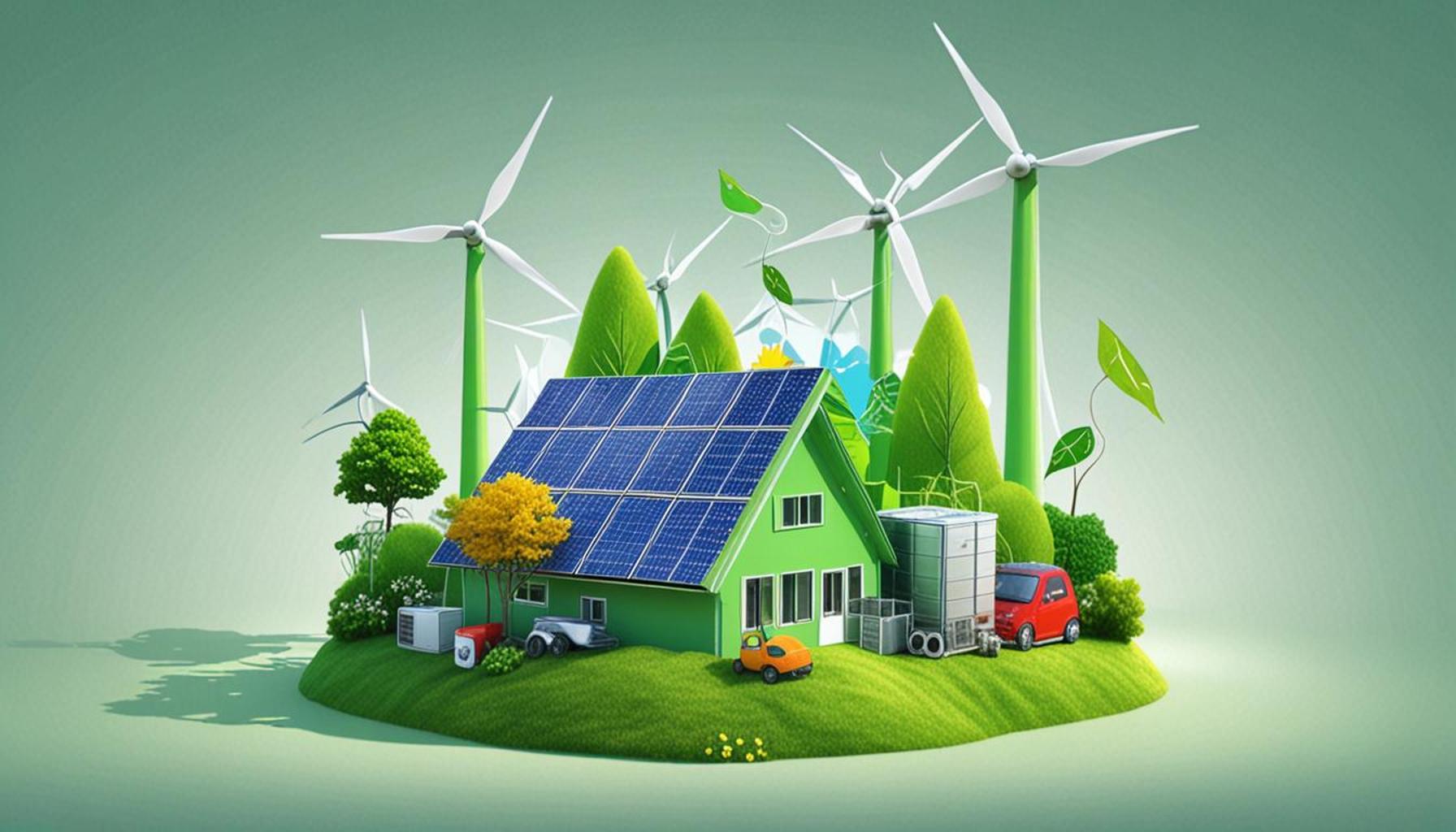Subsidy Programs for Renewable Energy: The Role of Government in the Green Transition

The Importance of Renewable Energy Subsidies
The transition toward renewable energy represents not just an environmental imperative but also a significant economic opportunity. As climate change escalates, driven by rising greenhouse gas emissions, the urgency for a clean energy shift becomes increasingly pronounced. In this context, governments around the world, particularly in the United States, are intensifying efforts to promote the adoption of renewable technologies through comprehensive subsidy programs. These initiatives not only address immediate climate goals but also lay the groundwork for a sustainable economic future.
Subsidy programs make renewable technologies more accessible and affordable. For instance, through financial incentives, individuals can benefit from significant reductions in the costs associated with installing solar panels or wind turbines. According to estimates from the Solar Energy Industries Association, residential solar costs have dropped dramatically—by about 70% since 2010—largely due to federal and state incentives. This reduction not only encourages homeowners to invest in solar energy but also fosters a marketplace driven by competition and innovation.
- Financial incentives: By lowering the initial costs of renewable energy technologies, subsidies enable widespread adoption, making green energy an economically viable choice for many households.
- Job creation: The rapid expansion of the renewable energy sector has led to the creation of over 200,000 jobs in the U.S. just in the solar industry alone, as reported by the U.S. Department of Energy. These include roles in manufacturing, installation, and maintenance, which contribute to local economies.
- Energy independence: Increased utilization of renewable resources reduces reliance on imported fossil fuels, enhancing national security. This shift not only supports domestic energy production but also stabilizes national energy prices, contributing to economic resilience.
In the U.S., initiatives like the Investment Tax Credit (ITC) and the Production Tax Credit (PTC) are crucial in promoting renewable projects. The ITC offers a tax deduction of 26% on solar energy installations, incentivizing both residential and commercial investments. Meanwhile, the PTC provides financial support per kilowatt-hour produced by wind and solar projects over a ten-year period, underpinning the financial viability of large-scale energy projects.
This analysis suggests that ongoing developments in subsidy frameworks will play a central role in shaping the renewable energy landscape. By evaluating the effectiveness of current programs and exploring new proposals, stakeholders can draw vital lessons in the ongoing effort against climate change. It becomes evident that government policies not only drive the green transition forward but also foster an environment conducive to innovation and job growth in the renewable sector, offering hope for a cleaner, brighter future.
RECOMMENDED: Check out this similar article
Understanding the Mechanisms of Renewable Energy Subsidies
Subsidy programs designed to support renewable energy technologies function through a mixture of direct financial support, tax incentives, and grants. These mechanisms aim to lessen the economic burden on consumers and businesses, thereby accelerating the transition to cleaner energy sources. The critical question remains: how effective are these subsidies in fostering a more sustainable energy landscape in the United States?
At the heart of subsidy programs are fiscal instruments that seek to incentivize investment and development in renewable energy. For example, the Investment Tax Credit (ITC) serves as a quintessential illustration of how tax incentives can catalyze market growth. By providing a substantial tax deduction for investments in solar energy installations, the ITC has propelled the solar market into uncharted territories. Initially set at 30%, the credit has gradually been reduced, which raises questions about the future trajectory of solar adoption in the absence of such robust support.
In addition to tax incentives, direct grants are essential in supporting innovative renewable energy projects. These funds often come from governmental bodies or public-private partnerships and are allocated to research and development initiatives that emphasize the creation of more efficient energy technologies. According to the U.S. Department of Energy, investments in clean energy research have totaled billions over recent years, reflecting a strong governmental commitment to enhancing technological capabilities. This investment is crucial as it not only augments energy production but also aligns with national objectives for innovation and environmental stewardship.
- Enhanced Market Competitiveness: Financial support through subsidies allows emerging renewable technologies to compete on an equal footing with established fossil fuel industries, leveling the playing field.
- Encouragement of Large-Scale Projects: Government subsidies can also drive large-scale renewable projects, leading to significant investments in infrastructure and services that bolster local economies.
- Accelerated Transition Timeline: With the right financial support, the timeline for transitioning from fossil fuels to renewable sources can be expedited, helping to meet pressing climate goals sooner.
Furthermore, it is crucial to recognize that the effectiveness of subsidy programs can vary widely based on geographic, economic, and technological factors. For instance, states such as California have successfully harnessed their subsidy frameworks to increase renewable energy installations significantly. On the contrary, regions with less favorable policies often lag, highlighting the need for tailored approaches to subsidy design.
As the renewable energy sector evolves, the role of government will undoubtedly remain influential. The effectiveness of subsidy programs hinges not solely on their availability but also on adaptive strategies that account for changing market dynamics, technological advancements, and public sentiment. Looking forward, policymakers must balance immediate financial incentives with long-term sustainability goals, embarking on a course that is not only economically sound but also environmentally imperative.
| Category | Key Features |
|---|---|
| Tax Credits | Federal tax incentives such as the Investment Tax Credit (ITC) and Production Tax Credit (PTC) significantly lower the economic burden of adopting renewable technologies. |
| Grants and Loans | Financial assistance through loans and grants fosters innovation and accelerates the deployment of clean energy solutions. |
| Feed-in Tariffs | Guaranteed pricing for renewable energy producers enhances investment certainty and promotes stability in emerging energy markets. |
| Research and Development (R&D) | Government funding for R&D initiatives drives technological advancement and reduces costs associated with renewable energy technologies. |
Subsidy programs for renewable energy are playing a critical role in facilitating the green transition. By providing essential financial support, these programs make the shift from fossil fuels to sustainable energy sources not only feasible but also attractive. Tax credits help to reduce the upfront costs for individuals and businesses wanting to invest in solar panels, wind turbines, and other renewable installations, effectively promoting a more sustainable energy landscape. In addition, grants and loans directed at startups and larger corporations serve as catalysts for innovation. These funds enable companies to develop new technologies that improve energy efficiency and lower emissions. Moreover, through mechanisms like feed-in tariffs, producers of renewable energy enjoy price guarantees that ensure long-term financial viability, thereby driving investments in this sector. The call to action here is clear; governments stand at the forefront of an essential movement, championing the cause of a cleaner, greener planet through well-structured subsidy programs. As interest grows, the exploration of these initiatives reveals not just benefits for the environment, but also for economic stability and job creation in the energy sector. Understanding the impact and scope of these programs is crucial for anyone interested in the future of energy policy and climate action.
CHECK OUT: Click here to explore more
The Impact of Subsidy Programs on Job Creation and Economic Growth
Subsidy programs for renewable energy do not merely serve a directive purpose of enhancing clean energy adoption; they also play a substantial role in driving job creation and stimulating economic growth. As the nation transitions to a green economy, the question arises: how do these subsidies translate into tangible employment opportunities and economic benefits?
According to a report by the International Renewable Energy Agency (IRENA), global employment in the renewable energy sector reached over 11 million jobs in 2018, a trend that continues to rise in the United States as well. Government subsidies are pivotal in this growth trajectory, fostering new job opportunities in sectors ranging from manufacturing to installation and maintenance of renewable technologies.
For instance, the wind energy sector has seen a dramatic increase in employment due to extensive government subsidies. The Production Tax Credit (PTC) incentivizes utility-scale wind projects, significantly increasing the demand for skilled labor in turbine construction and installation. States like Texas, which leads the nation in wind energy production, have leveraged these programs to create thousands of jobs, thereby bolstering local communities and economies.
- Local Economic Development: Subsidies not only create direct jobs but also result in secondary growth opportunities. For instance, increased activity in the renewable sector can lead to the establishment of local suppliers and services, multiplying job creation in nearby areas.
- Investment Attraction: The promise of public funding through subsidies can attract private investments. Investment in renewable energy projects can channel billions into the economy, impacting related industries such as construction, transportation, and manufacturing.
- Workforce Training and Development: Government subsidies often come with programs that invest in workforce development and training. By equipping the labor force with necessary skills, these programs ensure that workers can meet industry demands and facilitate an effective transition to renewable based jobs.
Moreover, the long-term sustainability of jobs created in the renewable energy sector can often be more resilient than those in traditional fossil fuel industries. A 2021 analysis from the U.S. Bureau of Labor Statistics indicates that jobs in renewable energy are projected to grow faster than the average for all occupations, underscoring the potential for a robust employment landscape over the coming decades.
Despite the apparent benefits, there remain challenges in aligning subsidy programs with job growth. For instance, the uneven distribution of renewable energy projects across states can lead to disparities in job creation. Policymakers must ensure that these subsidies are administered judiciously, facilitating a balanced approach that benefits various regions, including those historically reliant on fossil fuel industries.
The interaction between government subsidy programs and local economies points to a critical relationship: as subsidies foster growth in renewable energy, they also pave the way for community resilience and environmental sustainability. Yet, the question remains — will the potential for job creation and economic revitalization through subsidies be capitalized effectively in the pursuit of a greener future?
YOU MAY ALSO LIKE: Read read another article
Conclusion
In summary, subsidy programs for renewable energy are proving to be a cornerstone in the transition towards a green economy, facilitating not only the adoption of sustainable technologies but also significantly impacting job creation and economic growth across the United States. These initiatives serve as powerful tools that empower local communities, boost employment in various sectors, and attract substantial private investment, thereby shaping a resilient economic landscape.
Furthermore, by offering training and development programs, governments are equipping the workforce to adapt to new job markets, ensuring that the benefits of the green transition are inclusive. The projected job growth in renewable energy underscores the potential of these sectors to provide long-term employment opportunities beyond what traditional fossil fuel industries can offer.
However, it is imperative that policymakers remain vigilant in their approach, addressing disparities in project distribution and ensuring that the benefits of subsidies are felt nationwide. If executed judiciously, these programs can pave the way for a sustainable future, aligning economic interests with environmental goals. The ongoing dialogue about the effectiveness of subsidy initiatives is essential, urging stakeholders to explore innovative strategies that maximize their impact. Ultimately, the success of subsidy programs lies not just in fostering clean energy but in building a robust and equitable economy that thrives on sustainability, innovation, and resilience.



